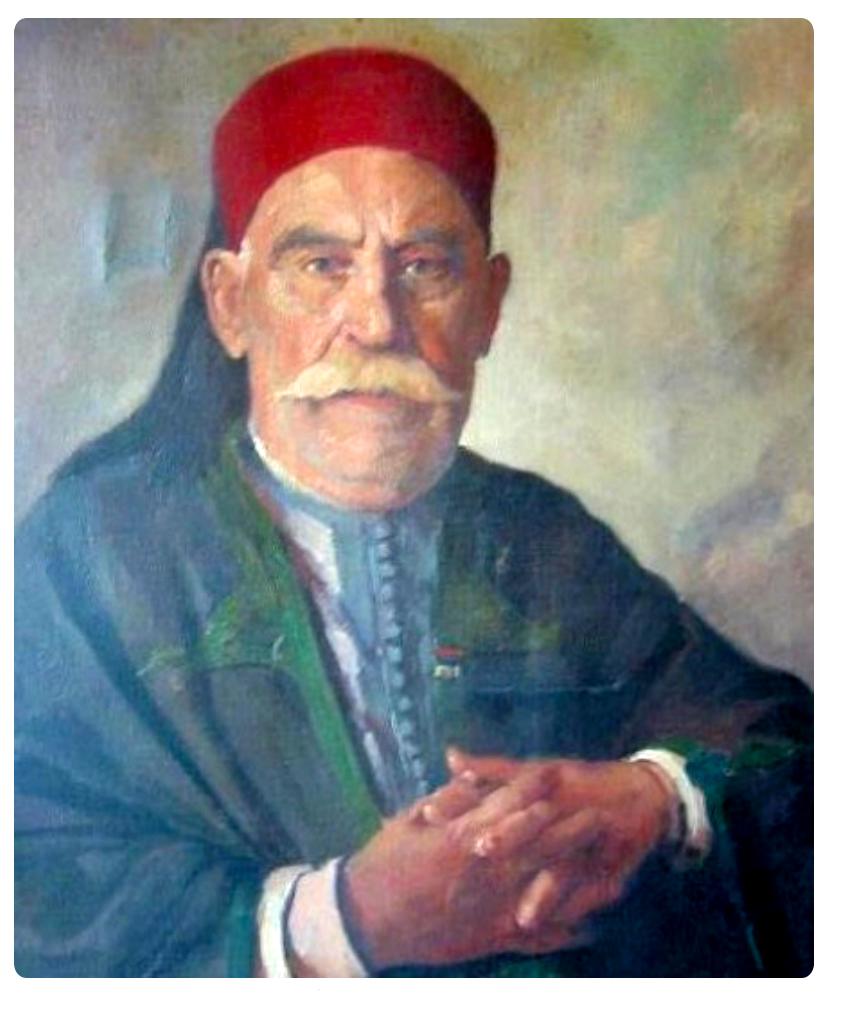

Read the following sections and use the information pop-ups to learn about the tiled walls, the magnificent ceiling, lantern, and upper lobby.
Use
 for pop-ups with more detail.
for pop-ups with more detail.



 The tile pictures of women on the left and right of the stairway are typical of Spanish art, in contrast to the geometric designs more common in Moorish art.
The tile pictures of women on the left and right of the stairway are typical of Spanish art, in contrast to the geometric designs more common in Moorish art.

Climb the richly decorated staircase lined with tiles from the first floor lobby to the second floor and the Mural Room. Although some of the tiles are of Spanish design, most with distinctive Moorish-Islamic geometric patterns, are from a Tunisian company owned by Jacob Chemla.
As shown in the Cast of Characters tour:
 From the landing, look up at the ceiling.
From the landing, look up at the ceiling.



The ceiling, painted by artist John Smeraldi,

As shown in the Cast of Characters tour:
 is a fine example of Mudejar (moo-DAY-har) style, identified by its geometric designs. The ceiling was inspired by a 14th Century synagogue in Toledo, Spain, and is made of wood planks suspended by cables from the concrete roof above. The eight-pointed star appears in spiritual traditions from many different cultures. It began to appear in Islamic art in the Middle ages, referred to as the “seal of the prophets.”
is a fine example of Mudejar (moo-DAY-har) style, identified by its geometric designs. The ceiling was inspired by a 14th Century synagogue in Toledo, Spain, and is made of wood planks suspended by cables from the concrete roof above. The eight-pointed star appears in spiritual traditions from many different cultures. It began to appear in Islamic art in the Middle ages, referred to as the “seal of the prophets.”


Courtesy Courthouse Legacy Foundation


 The beautiful jeweled ornament hanging from the bottom of the lantern has twenty-six points.
The beautiful jeweled ornament hanging from the bottom of the lantern has twenty-six points.

 The crowns on the top of the lanterns were in tribute to the ruling monarchs.
The crowns on the top of the lanterns were in tribute to the ruling monarchs.

This large lantern was inspired by the lanterns aboard old Spanish galleons. Called "faroles,” the lanterns were traditionally donated to churches following a successful voyage to the "New World.” The Courthouse lantern, which is more than ten feet tall, has a mechanism in the attic to lower it for maintenance. This is the largest of many custom lanterns throughout the Courthouse.



 Another example of the blending of diverse cultures is the Tree of Life. Trees of life, which had their origin in religious symbolism, are recounted in folklore, culture and fiction, often relating to immortality or fertility.
Another example of the blending of diverse cultures is the Tree of Life. Trees of life, which had their origin in religious symbolism, are recounted in folklore, culture and fiction, often relating to immortality or fertility.
 Magnificent stenciling of bird and tree patterns surrounds the upper area.
Magnificent stenciling of bird and tree patterns surrounds the upper area.The Romanesque Rose Window resembles those found in many European Christian churches.



 This large portrait of Cabrillo's landing painted by Daniel Groesbeck in 1924 inspired architect Mooser to hire him to create the murals that adorn the Mural Room.
This large portrait of Cabrillo's landing painted by Daniel Groesbeck in 1924 inspired architect Mooser to hire him to create the murals that adorn the Mural Room.

 The off-centered small arch within the larger arch provides an example of asymmetry, a prominent feature of Moorish architecture.
The off-centered small arch within the larger arch provides an example of asymmetry, a prominent feature of Moorish architecture.

 Smeraldi's Angels in Flight.
Smeraldi's Angels in Flight.

 These sturdy-looking columns are not load-bearing. They are actually hollow.
These sturdy-looking columns are not load-bearing. They are actually hollow.

Asymmetry is a prominent feature of Moorish architecture. These arches are an iconic example. Artist Smeraldi painted the angels in flight above the main arch to resemble Byzantine angels - another example representing the major monotheistic religions of the Andalusian area in early Spain.


Go to the fourth floor via the elevator or stairs, which continue in basic metal form on the next floor. There you will find the fascinating Bisno-Schall Clock Gallery. Through the window, you can see the inner workings of the Tower Clock. If you time your viewing with the sounding of the chimes to mark the hour, you will see the mechanism in action. For more information about the Clock Gallery, visit their detailed website.


Continue on the metal stairs, or take the elevator to the rooftop. You will find a 360° view of Santa Barbara, with explanation signs in each direction.
Photo Credits - Robert Dickey, Bill Espinosa, Marie Morrisroe except as otherwise noted. We hope you enjoyed your tour experience and we welcome your feedback. Please go to our feedback page.